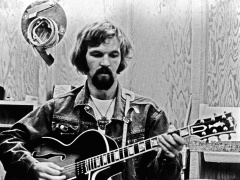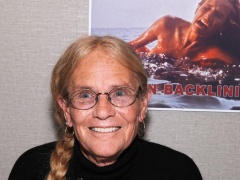
Rock and Roll Hall of Fame member Jerry Allison, who played to screaming crowds as a teenager as a member of the seminal 1950s rock band Buddy Holly and the Crickets and co-wrote some of their biggest hits, died Monday at age 82.
Allison’s writing contributions included co-penning “That’ll Be the Day” and “Peggy Sue.” He said he also co-wrote “Not Fade Away” with Holly but went uncredited, due to the producer allegedly switching his own name in instead.
Allison’s death was announced on the official Buddy Holly Facebook page. “Our sincerest condolences to the family and friends of Jerry ‘JI’ Allison, drummer in the Crickets, one of Buddy’s very closest friends, and the inspiration to drummers for decades since, who passed away today at the age of 82,” the notice read.
“JI was a musician ahead of his time, and undoubtedly his energy, ideas and exceptional skill contributed to both the Crickets and rock ‘n’ roll itself becoming such a success. Buddy is often heralded as the original singer-songwriter, but JI, too, wrote and inspired so many of the songs that would go on to be eternal classics. There’s more to be said and posted here in the coming days. For today, we think about his family and friends and wish JI to rest in peace.”
“That’ll Be the Day” was inducted into the Grammy Hall of Fame in 1998 and placed in the U.S. government’s National Recording Registry in 2005. It was a hit for Linda Ronstadt, as well, in the 1970s. It was said to be inspired by hearing John Wayne utter the title phrase in the film “The Searchers.” Holly and Allison first recorded it in 1956 with their seminal group Buddy Holly and the Three Tunes, but their charting version with the Crickets was cut the following year. It went to No. 1 on Billboard’s (Best Sellers chart (the precursor to the Hot 100). A Linda Ronstadt remake re-popularized the song in 1976.
“Peggy Sue” peaked at No. 3 later in 1957. The song was originally written as “Cindy Lou” but got renamed “Peggy Sue” in honor of Allison’s then estranged girlfriend and later wife, Peggy Sue Gerron. The song was inducted into the Grammy Hall of Fame in 1999.
Allison also had a minor solo hit, “Real Wild Child,” which he released under the name Ivan, with Holly backing him on guitar and vocals. The tune peaked at No. 68 on the Hot 100 in 1958. He had heard it sung by one of its co-writers, Australia’s Johnny O’Keefe, on a visit overseas and made the first recording of the tune. It came to be a rock standard, covered in later decades by Iggy Pop and others.
Holly went solo in 1958 and died in a plane crash the following year. The Crickets continued to perform together over the years with different frontmen, working with the singer-songwriter later to be known as Tonio K. in the mid-’70s. They served as backing band for country star Waylon Jennings in the late ’70s.
The Crickets were inducted in the Rock and Roll Hall of Fame in 2012, as the result of a committee determining that the band should have been inducted along with Holly when he was put in in 1986.
Allison was born in Hill County, Texas in 1939 and raised in Plainview until his family moved to Lubbock when he was 10. He started playing drums in the school band in Lubbock in the fifth grade, eventually performing the same duties in a college band at Texas Tech. Before that, though, he met Holly in junior high and became closer friends in high school.
“The halftime show at a football game made me want to whack the drums,” he said in an interview with Lubbock Online. “There were not a lot of opportunities for me to hear music in those days, but I liked Gene Krupa when I was growing up. As rock ‘n’ roll surfaced, I was totally impressed with Charles Conner. He played drums with Little Richard in a movie called ‘The Girl Can’t Help It.’ Buddy Holly and I watched that movie seven or eight times.”
He dropped out of college when the offers to back up stars with his friend started to come in. “Buddy got us a job backing Hank Thompson and George Jones and others for two weeks. We traveled 6,000 miles in two weeks,” he recalled in an interview with Texas Music Monthly. “I couldn’t stay in college.”
The Beatles have said that they were inspired to come up with their name by the Crickets. But the Crickets took inspiration, too. “Buddy and I were practicing one day,” Allison recalled, “and decided we needed a group name. We liked a record by the Spiders called ‘Witchcraft,’ so we decided to be insects. We looked in the dictionary under insects and stopped at cricket. We had a lot of crickets in Texas that year, too.”
Allison explained to Texas Music Monthly how their breakout hit came to be. “My bedroom in Lubbock was real big — in fact, it had a piano in it. Buddy and I rehearsed for hours, day after day. We’d been to see the John Wayne movie ‘The Searchers.’ Wayne kept repeating the line, ‘That’ll be the day.’ Buddy said, ‘Let’s write a song,’ and I said, ‘That’ll be the day!’ We worked on it for about half an hour.
“When Buddy got a record deal, we went to Nashville to record with Owen Bradley. Owen was a nice fellow, but he didn’t understand rock ’n’ roll — he was all country. So when he heard ‘That’ll Be the Day,’ he said, ‘That’s one of the worst songs I’ve ever heard.’
“We came home to Lubbock and formed the Crickets. We just looked at insect names in the black. We went to Clovis to record with Norman Petty, and ‘That’ll Be the Day’ was a demo — we recorded it in 30 minutes. Bob Thiele was the A&R man with Brunswick Records. He took the demo home and heard his kids playing it over and over. Bob released it, and it became a monster hit. We owed our success to Bob.”
Just as Allison said that his credit was left off “Not Fade Away” and replaced with one for producer Norman Petty, he also said that Holly himself was wrongly left off the credits of “Peggy Sue,” at first.
“I’m so lucky. I don’t want to complain, but Norman released this record and put his name and my name on it and left off Buddy!” he said in Texas Music Monthly. “After Buddy got killed, we were all in a lawyer’s office with [Holly’s widow] Maria Elena, and she said, ‘I know Buddy co-wrote ‘Peggy Sue,”’ and I said, ‘Of course he did.’ Norman said, ‘I need to see you in the hall.’ Norman tried to talk me into leaving the credit alone. I said, ‘I can’t do that.’ When we went back in, I said, ‘Buddy wrote half the song.’ Norman said, ‘I’m not giving up my half.’ I said ‘Take my half.’ After it was over, Norman got half the song, Buddy got 40 percent, and I got 10 percent.”
Allison was up-front about Holly being a more prolific writer than he was. Of “Peggy Sue,” he said in an interview with Classic Bands, “He had it about half-finished. We were riding around Lubbock and he had it written up as sort of a cha-cha beat or a rumba — a Latin feel. I said, ‘Let’s change the beat.’ I was dating Peggy Sue or had dated Peggy Sue at the time. There were some Cindy songs out at the time, but there weren’t any Peggy Sue ones. Peggy Sue probably helped. Whatever it was, Norman Petty’s engineering, Buddy’s guitar playing … it would’ve been hard to have been more commercial. It was a lovely, lovely time and people liked it and we were really pleased they did.”
Allison’s future wife had moved to California at the time they wrote the song, he recalled in another interview. If the song title change was designed at least in part to win her over, presumably it worked, since they did later wed? “She was impressed at the time, but I think she’s gotten over it,” he joked.
Allison’s drum part on “Peggy Sue” is a famous one, uncharacteristic of the early rock records of the day, but he downplayed there being anything special about it, saying in another interview: “Basically, that was just paradiddles. Just a basic old rudiment.”
The Crickets continued on for a few years after the split with Holly (with Allison maintaining that there had been no hard feelings about the solo move and they surely would have reunited if the singer’s life had not been cut tragically short). They backed the Everly Brothers for a time, and recorded with Bobby Vee in the early ’60s.
Original bassist Joe B. Mauldin continued on with the Crickets through his death in 2015. The following year, Allison and other members who had cycled through the Crickets over the decades performed together at a February 2016 show in Clear Lake, Iowa billed as “The Crickets and Buddies,” with Allison announcing after the concert that it would be their final show. Some of the players who had gone on to fame as session players who rejoined for the proceedings included Albert Lee, Sonny Curtis and Glen Hardin.
The band’s most famous latter-day album was 2004’s “The Crickets and Their Buddies,” which included star turns by Eric Clapton, John Prine, Nanci Griffith, Graham Nash, Rodney Crowell and one-time Crickets member Jennings, among others.






